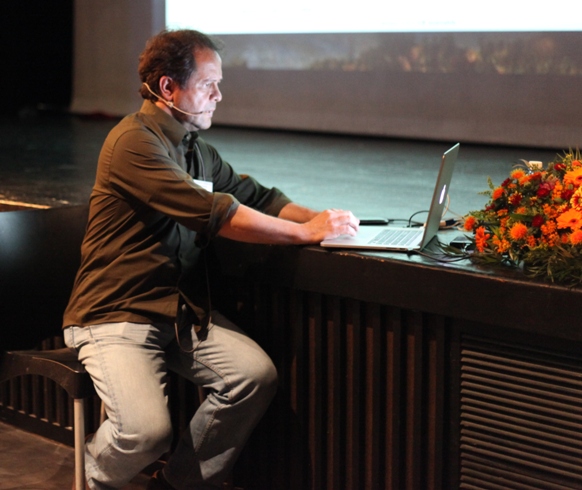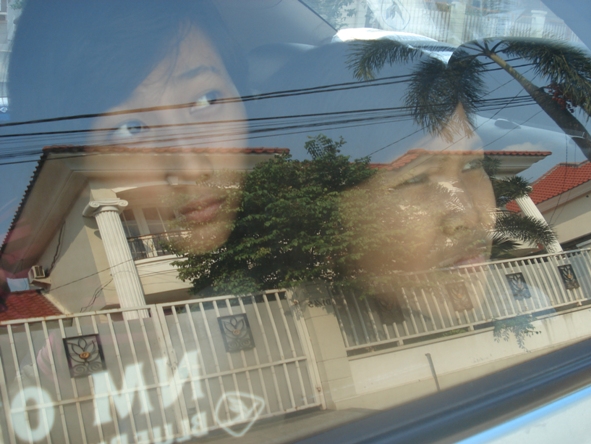
“My brothers and sisters were born in Indonesia, I was the first one born in the Netherlands, so there was a gap between me and all my brothers and sisters, because they always had some mystery I wanted to know,” said filmmaker Leonard Retel Helmrich, sharing the personal origins of his Indonesian trilogy. Helmrich and his films were featured at the annual conference on documentary film, an initiative of the New Fund for Cinema and TV (NFCT) in collaboration with The Israeli Documentary Filmmakers Forum and the Second Authority for Television and Radio, that took place in Tel Aviv from November 14 – 15, 2013.
The first two films in Helmrich’s trilogy, Eye of the Day (2001) and Shape of the Moon (2004), were screened at the conference, and the third, Position Among the Stars (2010) was shown on Channel 8. The documentary project spans thirteen years, reflecting the urgent issues of a people and country through the lives of three generations in the Sjamsuddin family: Rumijah, the grandmother, a devout Catholic in a predominantly Muslim country; Bakti, her all too laid back son; and her granddaughter Tari, orphaned at an early age, raised by Rumijah and Bakti, who hope she may attain a university education.
Helmrich, who is internationally recognized for making ‘impossible’ shots and filming entire scenes in a single shot, shared his perspective and expertise in two master classes at the conference. Although Helmrich’s focus might appear technical, and indeed he has devised unique tools such as the Steady Wing camera mount to facilitate his method of single shot cinema, there is a sense of intimacy, warmth and humor in the films that brings the viewer at once closer to the people and the greater issues which impact their lives, as well as an interplay between form and content, literal and symbolic, which delights the eye and makes an indelible imprint on the mind.

Access is almost a magic word in the making of documentaries, requiring the documentarian to maintain the delicate balance between insider and outsider. In that sense, learning more of Helmrich’s family background provides insight into his work, in particular the films on Indonesia. Helmrich enjoys the both the outsider’s perspective and freedom to observe, and the insider’s ability to decipher the cultural codes that often remain either invisible or opaque to outsiders. Helmrich related that his Dutch father was interred in a Japanese prison camp during World War II, “for having blue eyes.” After the war, he met and married Helmrich’s Javanese mother, and after several years the family moved to the Netherlands where Leonard Retel Helmrich was born.
“They were speaking a mix of Dutch and Indonesian,” said Helmrich of his siblings, “so I grew up knowing a bit of Indonesian, but I didn’t know that. I grew up as a normal human being in the Netherlands, I was raised that all I am is Dutch, and I felt really Dutch, until my mother passed away when I was thirty. I had just finished my studies in film school to become a director. When I had a chance to go to Indonesia, something changed in me.”
Helmrich described his experience of a sense of kinship to Indonesia, which had been for him, up to that point, a foreign country. “Wow, this country,” he recalled, “I saw all the little things that I thought were typical of me, that was the whole country… can you imagine that you make jokes and no one understands them in your own country, and then you come to another country and people understand your jokes? Also – the way I drive a car, I thought it was me, but there was a whole country doing the same thing!”
Helmrich’s journey to Indonesia was also a professional turning point. Having trained as a director of feature films, his first fiction film had just been released, yet, he said, “When I came to Indonesia, I thought reality is much bigger than anything. Real life is bigger than life, so why make fiction?”

The Indonesian trilogy came about through a combination of intention and serendipity. Helmrich was very interested in the political changes taking place in the country during the mid-1990s and thought of making a documentary about the student activists. When his filming of a demonstration led to a prison stay, Helmrich had to leave the country, returning only in 1997, at which time he learned that CNN and the BBC had already begun making documentaries on the subject. Trying to figure out “how can I tell this story from another angle?” Helmrich was spending time in the country and realized that the driver he had hired, a man named Bakti, and his extended family encompassed within their daily lives the very issues that he wanted to explore in his film: politics, religion and the economy.
What is ‘Single Shot Cinema’? The documentary filmmakers and film students attending the conference no doubt emerged with a richer understanding of the concept and method. Helmrich provided many examples of scenes from different films, including his most recent film Raw Herring (screened at Tribeca 2013), and was very good at explaining both the theoretical aspects of the various decisions made, and their execution in practice. He opened up the session to questions almost from the start, and the result was a stimulating conversation in film theory and practice, with Helmrich responding in generous detail to the audience’s interest, he even brought out a ‘Steady Wing.’
Yes, you really should have been there! For the curious layperson, Helmrich’s methods might be described as “using camera movements to tell your story.” He achieves this by holding the camera slightly lower than eye-level, and focusing himself on whatever or whoever draws his interest, remaining with that person and as he described “orbiting” around that focal point. This makes for some fascinating scenes, such as the scene in Shape of the Moon when a man walks across a railroad track high above a valley, or in Position Among the Stars when he follows a small boy running through the alleys of Jakarta, conveying the mystery and excitement inherent in these moments.
His approach is always very hands-on and personal, filming and directing his films, finding ways to augment his equipment as needed, often using available materials in creative ways. The camera represents the emotional point of view of the film, as he explained, “You always dream from an emotional point of view.” For Helmrich, the camera is like a “writing pencil” or “painter’s brush.” He said, “Film is an art form, I would never give the camera to someone else.”
As for the Sjamsuddin family, there is a happy epilogue: Tari completed her university studies and is now working in Indonesian television.





